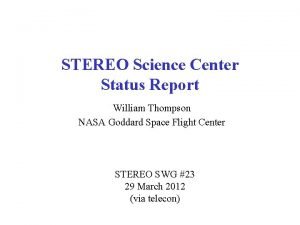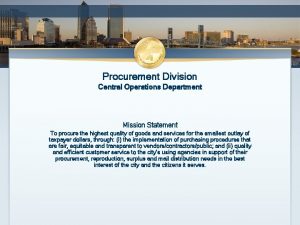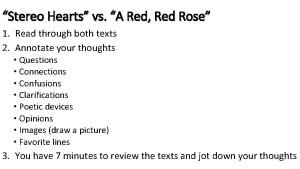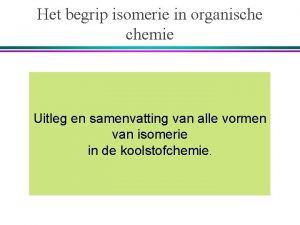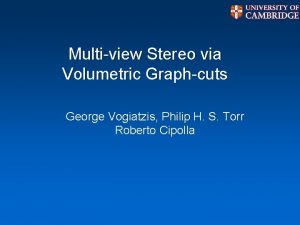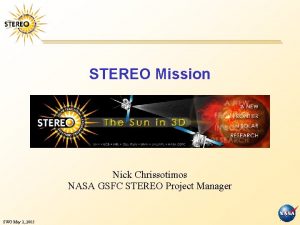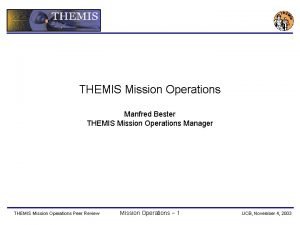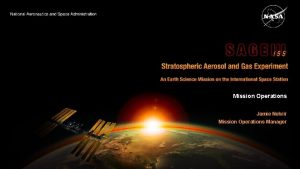STEREO Science Operations Plan for the extended mission










- Slides: 10

STEREO Science Operations Plan for the extended mission William Thompson NASA Goddard Space Flight Center STEREO SWG 27 -29 October 2009 Meredith, NH

Science Operations Plan • Revised STEREO Science Operations Plan is now complete, and has started the signature process. Date Ahead Date Behind Downlink (kbps) Pass duration (hrs) Daily volume (Gbits) Jan 2007 720 4 5 Oct 2008 Sep 2008 480 5 5 May 2009 June 2009 360 6 5 Apr 2010 Dec 2009 240 7 4 Sep 2010 160 8 2. 7 Apr 2011 Nov 2010 120 8 2. 1 Sep 2011 96 8 1. 7 Aug 2012 30 10 0. 6

Extended Mission Strategy • Space weather beacon telemetry will be unaffected. – SECCHI SWx telemetry will not be downlinked from the SSR. • Spacecraft housekeeping rates will drop proportionally to the overall rate. • Instruments will only put (enhanced) housekeeping data in the realtime stream, with science data written to the SSR. – SECCHI already does this. The SECCHI housekeeping rate will drop from the current 3. 6 kbps to 2. 2 kbps. This will drop again to 1. 2 kbps when the overall rate drops to 96 kbps. – Optional realtime modes for special instrument operations, used rarely • All instruments, including the in situ instruments, will lower their science rates.

Realtime telemetry from SOP May not be implemented

Instrument rates from SOP

IMPACT Strategy • 160 kbps: – Eliminate STE-U – Eliminate SWEA onboard PADS • 120 kbps: – Reduce burst data to one per day – Eliminate “Burst criteria” • 96 kbps: – Same as 120 kbps – If additional reduction needed, then remove burst entirely

PLASTIC Strategy • 160 kbps: – Delete high resolution matrix rates • 120 kbps: – Reduce time resolution for ion species matrix rates from 5 (10) minutes to 20 (20) minutes. • 96 kbps: – Examining two options: • Delete one of the solar wind alpha rates • Reduce the time resolution for ion species matrix rates to 30 (30) minutes.

SWAVES Strategy • 160 kbps: – Reduce the frequency resolution in the high frequency band. • 120 kbps: – Reduce time resolution to one sweep per minute (currently ~2/min) • 96 kbps: – Reduce the number of time domain bursts

SECCHI Strategy • EUVI: – Increase compression for most images – Reduce cadence to 2 hours for all but 1 wavelength • COR 1/COR 2: – Bin to smaller images – Send down only total brightness – Reduce cadence • HI 1/HI 2: – – – High resolution images only once/week (currently once/day) Change HI 1 cadence from 40 to 60 minutes Send down only portion of image Change HI 2 cadence from 2 hours to 3 hours Bin to smaller images

What happens next? • The following changes are to be made for the drop to 240 kbps: – – – Stop downloading SECCHI space weather partition from the SSR Start using the new lower realtime rates for all the instruments Lower the spacecraft housekeeping rate SECCHI will adjust their telemetry volume The in-situ SSR telemetry volumes will be unchanged • SECCHI may also request two new DFD entries: – One to downlink only SSR 1, and not SSR 2 – One to downlink both SSR 1 and SSR 2, with more priority for SSR 2 than currently used • SECCHI team also discussing changing the relative sizes of SSR 1 and SSR 2
